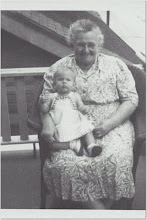Today in History: November 12, 1956, the world's largest observed iceberg was spotted by the U.S.S. Glacier in the South Pacific ocean off Scott Island in the Antarctic. The size was 280 long X 60 miles wide - about the land size of Belgium. The iceberg pictured here is a much earlier berg, and though quite massive is small compared to the 1956 monstrosity.

This beautiful iceberg floated off Labrador around 1909 based on the postmark of Jun 2, 1910.
If you look carefully you will see the hospital ship Strathcona passing through the arch. Dr. Grenfel (Sir Wilfred Grenfel) took quite a risk, sailing through the opening in the berg. What he and his crew saw was just the "tip of the iceberg".
In 1892 and for many years after Dr. Grenfel provided much needed healthcare to fisherman, settlers and aboriginal people on Newfoundland. He founded hospitals, churches and orphanges and provided many other services in the area he served. This quote is ascribed to him:
"The service we render to others is really the rent we pay for our room on this earth. It is obvious that man is himself a traveler; that the purpose of this world is not 'to have and to hold' but 'to give and serve.' There can be no other meaning."
 What lies below is very dangerous, and many ships have been badly damaged and/or sunk by the unseen. Only about 1/9th of the mass is visible.
What lies below is very dangerous, and many ships have been badly damaged and/or sunk by the unseen. Only about 1/9th of the mass is visible.
The RMS (Royal Mail Ship)Titanic is just one notable example of the dangers icebergs present. Lessons learned from the sinking of this huge vessel brought about many new safety measures and seafaring laws in hopes of avoiding such a tragic and unnecessary loss of lives.
The International Ice Patrol is an organization with the purpose of monitoring the presence of icebergs in the northern Atlantic ocean and reporting their movements for safety purposes. It is operated by the United States Coastguard but is funded by the 13 nations interested in trans-Atlantic navigation.
It was established in 1914 in response to the sinking of the RMS Titanic. According to the Patrol's Deputy Commander, U.S. Coast Guard Lieutenant Commander Gabrielle McGrath, "The primary mission of the Ice Patrol is to alert any sea craft traveling the great circle shipping lanes between Europe and the major ports of the United States and Canada of the presence of any icebergs there.
This is thought to be the iceberg that sunk the Titanic. The dark edge is red paint scraped from the ship.
The NIC , U.S. National Ice Center, monitors ice bergs world wide now. Most of their notifications, data and information come from polar circling satellites and remote sensors.
The NIC , U.S. National Ice Center, monitors ice bergs world wide now. Most of their notifications, data and information come from polar circling satellites and remote sensors.
The iceberg shown on this postcard looks much like the remains of the Battle Harbor iceberg.
The word iceberg is from the Dutch, ijsberg, meaning "ice mountain". They come in many sizes; the smallest is called a growler (less than a meter to 16 meters) and successive sizes are called bergie bits, small, medium, large and very large. Even growlers can cause major damage to a ship.
These mountains of ice are not necessarily quiet. They are filled with pockets of air compressed over thousands of years. As they melt the released air fizzes and pops and the sound is called a Bergie Seltzer.

This "iceberg" in Detroit is an annual winter sight. The water is purposely left running and each year a beautiful ice cathedral is formed.
For more Postcard Friendship Friday fun stop by Beth's at The Best Hearts Are Crunchy.
As always most of the information in this post results from an out of control train of thought process that leads me from one subject to another. I reference on-line (heavy on Wikipedia) and "on-hand" source material plus the vast wealth of completely useless trivia I have accumulated in me brain over the years. Pictures are unceremoniously and shamelessly lifted from flickr and Wikipedia. Postcard images are used with kind permission from www.cardcow.com





































.JPG)





































5 comments:
Love the picture of ship coming through the iceberg but the underwater iceberg view gives pause for thought. The Detroit 'iceberg' must be a magical sight. I now know a lot more about icebergs, great post.
Fascinating. As ice melts (global warming), we may depend on postcards for historical information!!! I bet the Detroit iceberg is fun to see/watch as it grows!
That's one big iceberg! I think I'd be a little nervous to sail through it!
I had no idea that icebergs could be quite as big as the ones you mention! This is a fascinating post and very much suits my thought processes too. :) I worked in Southampton for many years and the memories of Titanic there are still very vivid, so many people had close connections.
I like more and more your blogging style. "Le style c'est l'homme". :)
Post a Comment